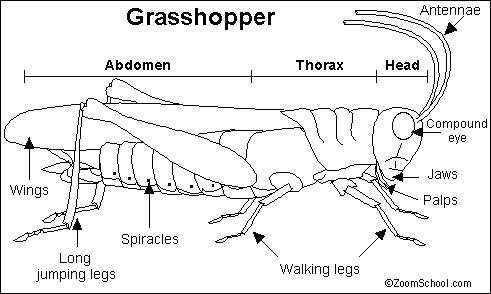
 |
| You might also like: | Green Things: Printable Color Book | Label Grasshopper Anatomy Printout | Label Cricket Anatomy Printout | Cricket Printout | Housefly Printout | Today's featured page: Hokusai: Wave Coloring Page |
| Label Grasshopper Anatomy Printout | EnchantedLearning.com |
Animal Printouts Label Me! Printouts |


Metamorphosis: Grasshoppers undergo simple (or incomplete) metamorphosis; eggs hatch into nymphs, which look like little adults without wings and reproductive organs. Nymphs molt many times as they grow to be adults.
Anatomy: Like all insects, the grasshoppers have a three-part body (head, thorax and abdomen), six jointed legs, two pairs of wings, and two antennae. Their body is covered with a hard exoskeleton. Grasshoppers breathe through a series of holes called spiracles; they are located along the sides of the body. Most grasshoppers are green, brown, or olive-green. The biggest ones are about 4.5 inches (11.5 cm) long.
The Legs: The long hind legs are used for hopping. The short front legs are used to hold prey and to walk.
Diet and Predators: Grasshoppers eat plants. Their predators include birds, beetles, rodents, reptiles, and spiders. Some flies also eat grasshopper eggs.
| Search the Enchanted Learning website for: |